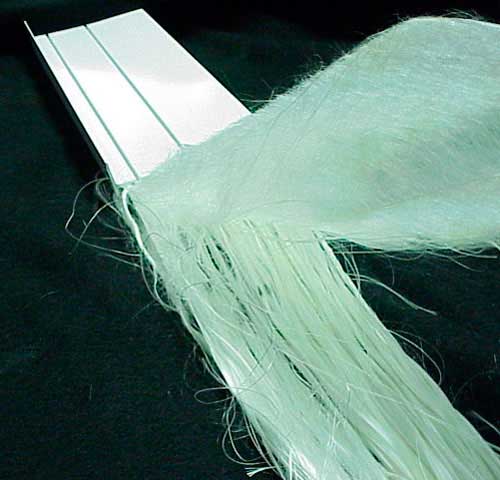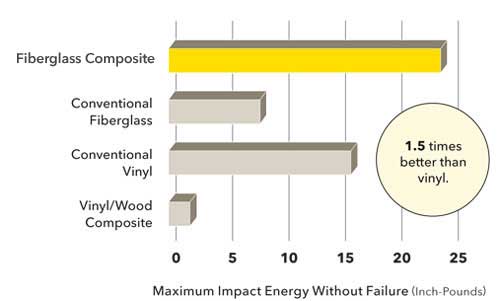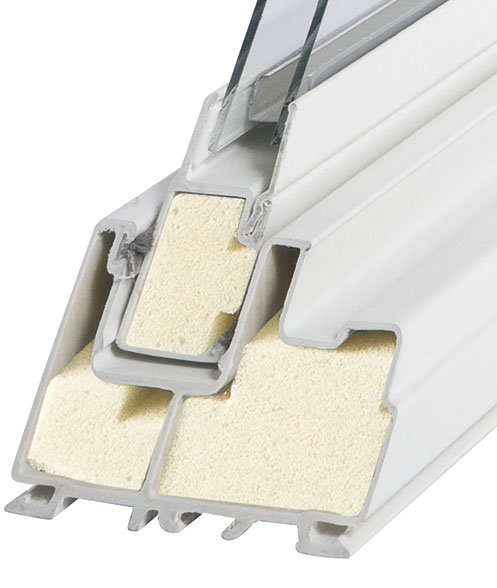Fiberglass Windows: A Sustainable Choice in Non-Residential and Multi-Family Buildings
The process of making fiberglass window frames is also different from making aluminum or vinyl frames where the process of extrusion is used, which means the material is pushed through a die to shape. Instead, fiberglass frames rely on a process called pultrusion, in which thousands of glass fibers (called rovings) are pulled through a steel die. (See Figure 1.)The resin and fiber are given shape as they are pulled through the die which is heated to initiate the resin's cure process. The hardened result is then cut to the desired length and prepared for finishing. A paint finish is applied to the fiberglass to provide the final coloring and UV resistance to protect the finished product from sun exposure. Â In testing performed in accordance with the American Society of Testing and Materials (ASTM) testing standards, fiberglass composites manufactured in this manner consistently display superior performance in strength, ability to withstand extreme heat and cold, and resistance to dents and scratches.
 |
Figure 1:Fiberglass being mixed with thermo-set resin in a pultrusion process to form a stable, strong, material. Photo courtesy of Pella Corporation |
Â
There are several characteristics of fiberglass composite windows that have contributed to their increased use in commercial and institutional buildings, including:
- Durability. In addition to its great strength, certain factory-applied finishes render fiberglass composite virtually indestructible and long lasting. Further, it will not corrode or rot.
- Impact resistance. (See Figure 2.) Fiberglass composite withstands major impacts without deformation, especially in cold weather. Impact resistance is particularly important on the job site during installation, when dents and damage may inadvertently occur.
 |
Figure 2:Fiberglass impact resistance compared to other window materials Image courtesy of Pella Corporation |
- Hot and cold performance.Fiberglass composite can handle a wide range of temperature extremes, withstanding heat up to 200 degrees Fahrenheit, and cold to -40 degrees Fahrenheit.
- Thermal expansion. (See Figure 3.) Fiberglass composite has a very low coefficient of expansion which is very similar to glass. As a result, it moves very little as the weather changes, resulting in less stress on the installation, seals, and glazing of the window. In addition, since fiberglass composite is very heat tolerant, it can be painted dark colors without concern for heat deformation.
 |
Figure 3:Fiberglass thermal expansion compared to other window materials Image courtesy of Pella Corporation |
- Energy efficiency. (See Figure 4a & b.) Fiberglass composites rank high because of their inherently low heat conductivity. Further, they are commonly offered with added insulation inside the cavities of the frames and sash, boosting the overall thermal resistance value of the unit. As a result, the material also has a higher condensation resistance than other materials. As shown in Figure 4a, fiberglass window units rate 2.4 times better than aluminum with a thermal break and even better compared to aluminum frames without a thermal break. As a result, they also provide superior thermal comfort to those seated near windows.
 |
Figure 4a: Fiberglass energy efficiency compared to other window materials. Image courtesy of Pella Corporation |
 |
Figure 4b: Frames and sash can be filled with foam insulation for added energy efficiency. Image courtesy of Pella Corporation |
- Sustainability. Fiberglass composites consume less embodied energy to produce when compared to aluminum and vinyl.
- High performance. The finished units provide excellent resistance to air and water infiltration particularly in high winds making them very appropriate for coastal applications. They also serve as effective sound barriers between outdoor and indoor spaces.
- Finish. The final factory applied finish coat is typically scratch resistant, low-maintenance, and resists chalking and fading-even in dark colors.
- Installation, operation and maintenance. Fiberglass composite units typically arrive on-site pre-assembled and pre-finished, which makes them easy to install, and low maintenance over the long term.
The net result of all of these characteristics is that fiberglass composite windows offer an advanced alternative for commercial buildings of all types. They provide exceptional energy efficiency and durability even in extreme weather conditions while combining the beauty of durable finishes with the outstanding performance commercial projects demand.









